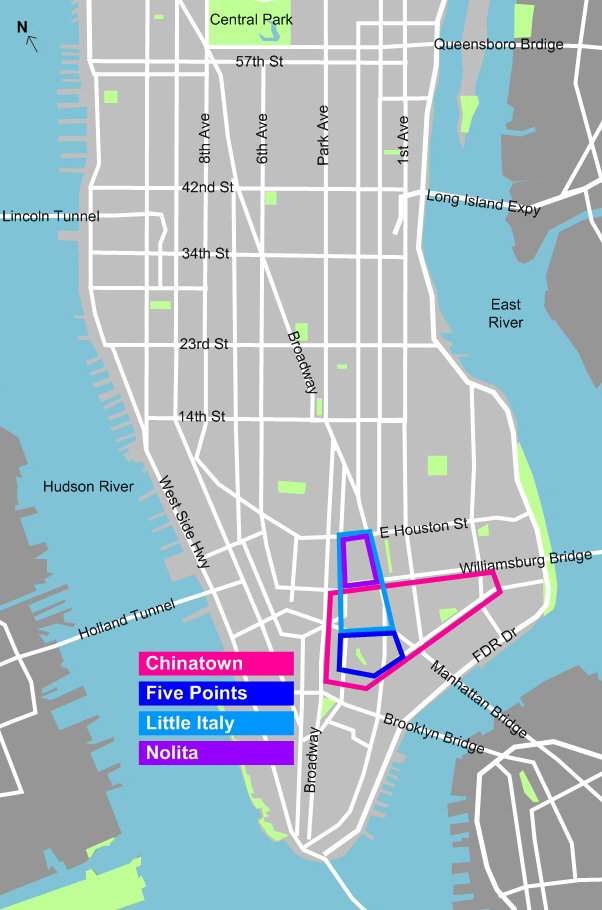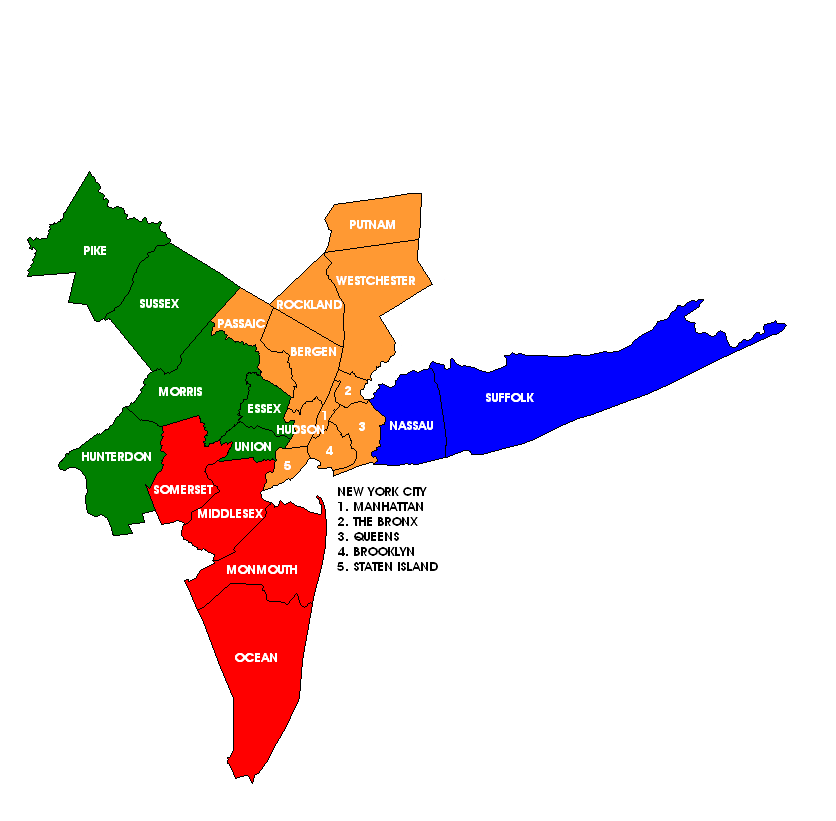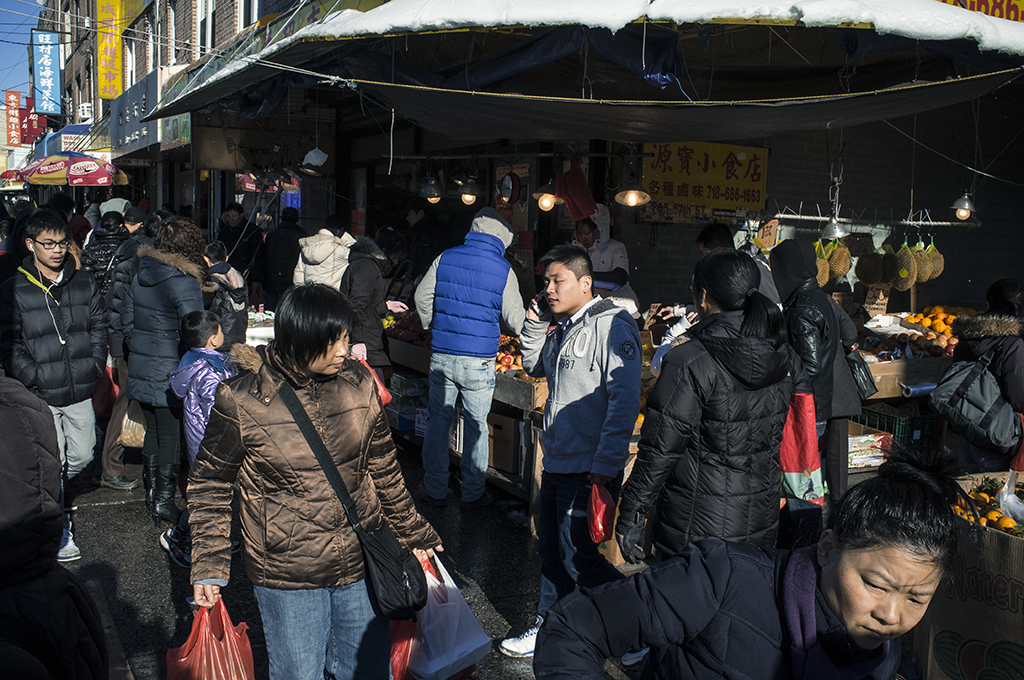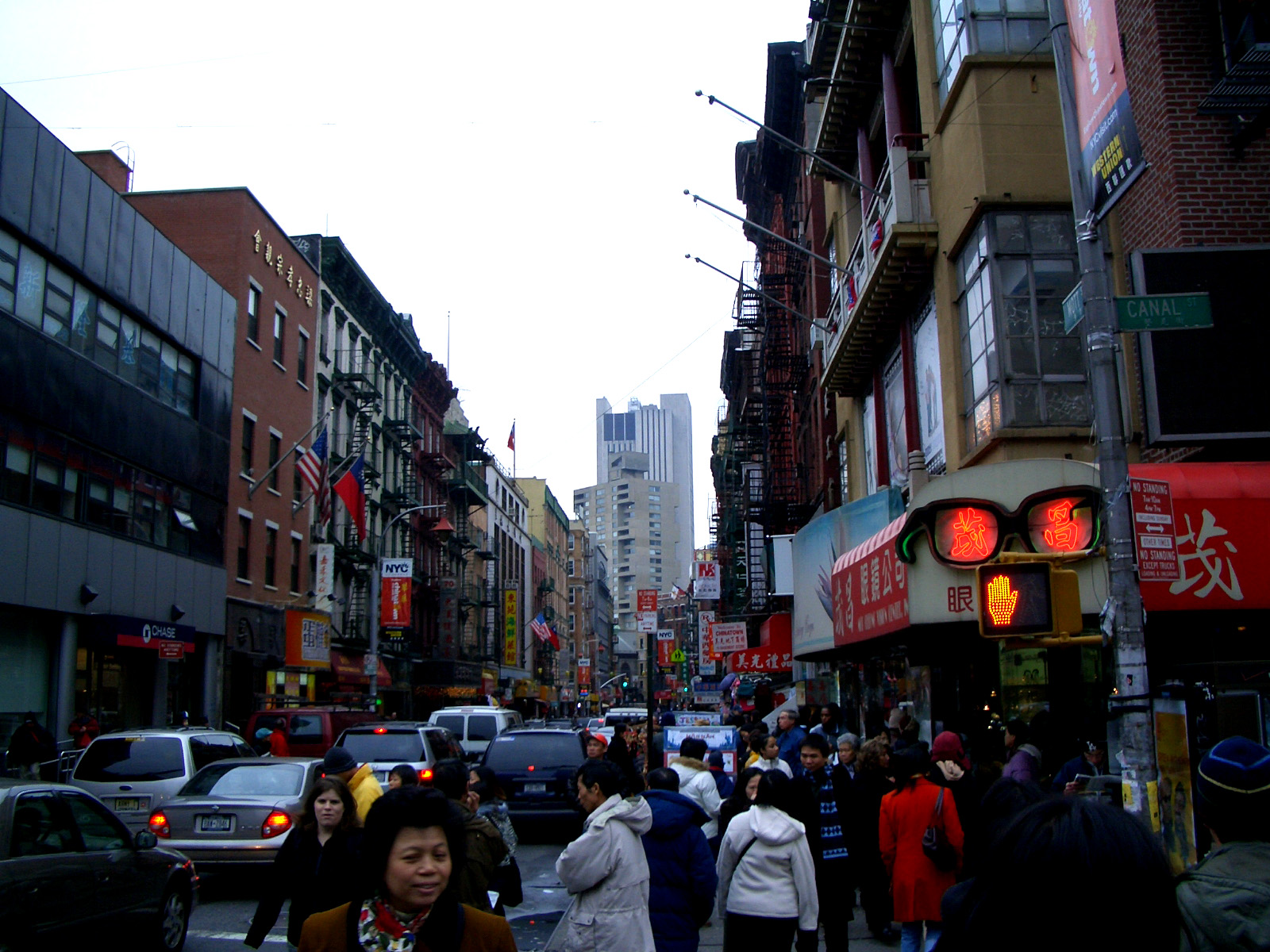|
Chinatown (Manhattan)
Manhattan's Chinatown () is a neighborhood in Lower Manhattan, New York City, bordering the Lower East Side to its east, Little Italy to its north, Civic Center to its south, and Tribeca to its west. With an estimated population of 90,000 to 100,000 people, Chinatown is home to the highest concentration of Chinese people in the Western Hemisphere.* * * * * Manhattan's Chinatown is also one of the oldest Chinese ethnic enclaves. The Manhattan Chinatown is one of nine Chinatown neighborhoods in New York City, as well as one of twelve in the New York metropolitan area, which contains the largest ethnic Chinese population outside of Asia, comprising an estimated 893,697 uniracial individuals as of 2017. Historically, Chinatown was primarily populated by Cantonese speakers. However, in the 1980s and 1990s, large numbers of Fuzhounese-speaking immigrants also arrived and formed a sub-neighborhood annexed to the eastern portion of Chinatown east of The Bowery, which has beco ... [...More Info...] [...Related Items...] OR: [Wikipedia] [Google] [Baidu] |
List Of Manhattan Neighborhoods
This is a list of neighborhoods in the New York City Boroughs of New York City, borough of Manhattan arranged geographically from the north of the island to the south. The following approximate definitions are used: *Upper Manhattan is the area above 96th Street (Manhattan), 96th Street. *Midtown Manhattan is the area between 34th Street (Manhattan), 34th Street and 59th Street (Manhattan), 59th Street. *Lower Manhattan is the area below 14th Street (Manhattan), 14th Street. *West Side (Manhattan), West Side is the area west of Fifth Avenue; East Side (Manhattan), East Side is the area east of Fifth Avenue. Neighborhood names and boundaries are not officially defined. They may vary or change from time to time due to demographic and economic variables. Uptown neighborhoods Midtown neighborhoods Between Midtown and Lower Manhattan †Large scale developments Lower Manhattan neighborhoods †Large scale developments Islands * Ellis Island * Governors Island * Liberty Islan ... [...More Info...] [...Related Items...] OR: [Wikipedia] [Google] [Baidu] |
Lower Manhattan
Lower Manhattan (also known as Downtown Manhattan or Downtown New York) is the southernmost part of Manhattan, the central borough for business, culture, and government in New York City, which is the most populated city in the United States with over 8.8 million residents as of the 2020 census. Lower Manhattan is defined most commonly as the area delineated on the north by 14th Street, on the west by the Hudson River, on the east by the East River, and on the south by New York Harbor. The Lower Manhattan business district, known as the Financial District (FiDi), forms the main core of the area below Chambers Street. It is a leading global center for commerce, housing Wall Street, the New York Stock Exchange, and the Federal Reserve Bank of New York. The city itself originated at the southern tip of Manhattan Island in 1624 at a point that now constitutes the present-day Financial District. The population of the Financial District alone has grown to an estimated 61,000 resid ... [...More Info...] [...Related Items...] OR: [Wikipedia] [Google] [Baidu] |
Cantonese
Cantonese ( zh, t=廣東話, s=广东话, first=t, cy=Gwóngdūng wá) is a language within the Chinese (Sinitic) branch of the Sino-Tibetan languages originating from the city of Guangzhou (historically known as Canton) and its surrounding area in Southeastern China. It is the traditional prestige variety of the Yue Chinese dialect group, which has over 80 million native speakers. While the term ''Cantonese'' specifically refers to the prestige variety, it is often used to refer to the entire Yue subgroup of Chinese, including related but largely mutually unintelligible languages and dialects such as Taishanese. Cantonese is viewed as a vital and inseparable part of the cultural identity for its native speakers across large swaths of Southeastern China, Hong Kong and Macau, as well as in overseas communities. In mainland China, it is the ''lingua franca'' of the province of Guangdong (being the majority language of the Pearl River Delta) and neighbouring areas such as Guang ... [...More Info...] [...Related Items...] OR: [Wikipedia] [Google] [Baidu] |
New York Metropolitan Area
The New York metropolitan area, also commonly referred to as the Tri-State area, is the largest metropolitan area in the world by urban area, urban landmass, at , and one of the list of most populous metropolitan areas, most populous urban agglomerations in the world. The vast metropolitan area includes New York City, Long Island, the Mid and Lower Hudson Valley in the State of New York; the six largest cities in New Jersey: Newark, New Jersey, Newark, Jersey City, New Jersey, Jersey City, Paterson, New Jersey, Paterson, Elizabeth, New Jersey, Elizabeth, Lakewood, New Jersey, Lakewood, and Edison, New Jersey, Edison, and their vicinities; and six of the seven largest cities in Connecticut: Bridgeport, Connecticut, Bridgeport, Stamford, Connecticut, Stamford, New Haven, Connecticut, New Haven, Waterbury, Connecticut, Waterbury, Norwalk, Connecticut, Norwalk, and Danbury, Connecticut, Danbury, and the vicinities of these cities. The New York metropolitan area comprises the geograp ... [...More Info...] [...Related Items...] OR: [Wikipedia] [Google] [Baidu] |
Chinese Americans In New York City
The New York metropolitan area is home to the largest and most prominent ethnic Chinese population outside of Asia, hosting Chinese populations representing all 34 provincial-level administrative units of China. The Chinese American population of the New York City metropolitan area was an estimated 893,697 as of 2017, constituting the largest and most prominent metropolitan Asian national diaspora outside Asia. New York City itself contains by far the highest ethnic Chinese population of any individual city outside Asia, estimated at 628,763 as of 2017. New York City and its surrounding metropolitan area, including Long Island and parts of New Jersey, is home to 12 Chinatowns, early U.S. racial ghettos where Chinese immigrants were made to live for economic survival and physical safety that are now known as important sites of tourism and urban economic activity. Six Chinatowns (or nine, New York including the emerging Chinatowns in Elmhurst and Whitestone, Queens, and East Har ... [...More Info...] [...Related Items...] OR: [Wikipedia] [Google] [Baidu] |
Ethnic Enclave
In sociology, an ethnic enclave is a geographic area with high ethnic concentration, characteristic cultural identity, and economic activity. The term is usually used to refer to either a residential area or a workspace with a high concentration of ethnic firms.Portes, Alejandro, and Leif Jensen. "Disproving the Enclave Hypothesis: Reply." ''American Sociological Review''. Vol. 57. no. 3 (1992): 418-420. Their success and growth depends on self-sufficiency, and is coupled with economic prosperity. The theory of social capital and the formation of migrant networks creates the social foundation for ethnic enclaves. Douglas Massey describes how migrant networks provide new immigrants with social capital that can be transferred to other tangible forms.Massey, Douglas S. "Annals of the American Academy of Political and Social Science." Annals of the American Academy of Political and Social Science. Vol. 510. World Population: Approaching the Year 2000 (Jul., 1990): pp. 60. As immigran ... [...More Info...] [...Related Items...] OR: [Wikipedia] [Google] [Baidu] |
Overseas Chinese
Overseas Chinese () refers to people of Chinese birth or ethnicity who reside outside Mainland China, Hong Kong, Macau, and Taiwan. As of 2011, there were over 40.3 million overseas Chinese. Terminology () or ''Hoan-kheh'' () in Hokkien, refers to people of Chinese citizenship residing outside of either the PRC or ROC (Taiwan). The government of China realized that the overseas Chinese could be an asset, a source of foreign investment and a bridge to overseas knowledge; thus, it began to recognize the use of the term Huaqiao. Ching-Sue Kuik renders in English as "the Chinese sojourner" and writes that the term is "used to disseminate, reinforce, and perpetuate a monolithic and essentialist Chinese identity" by both the PRC and the ROC. The modern informal internet term () refers to returned overseas Chinese and ''guīqiáo qiáojuàn'' () to their returning relatives. () refers to people of Chinese origin residing outside of China, regardless of citizenship. Another ofte ... [...More Info...] [...Related Items...] OR: [Wikipedia] [Google] [Baidu] |
Chinatown
A Chinatown () is an ethnic enclave of Chinese people located outside Greater China, most often in an urban setting. Areas known as "Chinatown" exist throughout the world, including Europe, North America, South America, Asia, Africa and Australasia. The development of most Chinatowns typically resulted from mass migration to an area without any or with very few Chinese residents. Binondo in Manila, established in 1594, is recognized as the world's oldest Chinatown. Notable early examples outside Asia include San Francisco's Chinatown, San Francisco, Chinatown in the United States and Melbourne's Chinatown, Melbourne, Chinatown in Australia, which were founded in the mid-19th century during the California Gold Rush, California and Victorian gold rush, Victoria gold rushes, respectively. A more modern example, in Montville, Connecticut, was caused by the displacement of Chinese workers in the Chinatown, Manhattan, Manhattan Chinatown following the September 11th attacks in 2001. ... [...More Info...] [...Related Items...] OR: [Wikipedia] [Google] [Baidu] |
Western Hemisphere
The Western Hemisphere is the half of the planet Earth that lies west of the prime meridian (which crosses Greenwich, London, United Kingdom) and east of the antimeridian. The other half is called the Eastern Hemisphere. Politically, the term Western Hemisphere is often used as a metonymy for the Americas, even though geographically the hemisphere also includes parts of other continents. . Geography The Western Hemisphere consists of the , excluding some of the |
Chinese People In New York City
The New York metropolitan area is home to the largest and most prominent ethnic Chinese population outside of Asia, hosting Chinese populations representing all 34 provincial-level administrative units of China. The Chinese American population of the New York City metropolitan area was an estimated 893,697 as of 2017, constituting the largest and most prominent metropolitan Asian national diaspora outside Asia. New York City itself contains by far the highest ethnic Chinese population of any individual city outside Asia, estimated at 628,763 as of 2017. New York City and its surrounding metropolitan area, including Long Island and parts of New Jersey, is home to 12 Chinatowns, early U.S. racial ghettos where Chinese immigrants were made to live for economic survival and physical safety that are now known as important sites of tourism and urban economic activity. Six Chinatowns (or nine, New York including the emerging Chinatowns in Elmhurst and Whitestone, Queens, and East Har ... [...More Info...] [...Related Items...] OR: [Wikipedia] [Google] [Baidu] |
Tribeca
Tribeca (), originally written as TriBeCa, is a neighborhood in Lower Manhattan in New York City. Its name is a syllabic abbreviation of "Triangle Below Canal Street". The "triangle" (more accurately a quadrilateral) is bounded by Canal Street, West Street, Broadway, and Chambers Street. By the 2010s, a common marketing tactic was to extend Tribeca's southern boundary to either Vesey or Murray streets to increase the appeal of property listings. The neighborhood began as farmland, then was a residential neighborhood in the early 19th century, before becoming a mercantile area centered on produce, dry goods, and textiles, and then transitioning to artists and then actors, models, entrepreneurs and other celebrities. The neighborhood is home to the Tribeca Festival, which was created in response to the September 11 attacks, to reinvigorate the neighborhood and downtown after the destruction caused by the terrorist attacks. Tribeca is part of Manhattan Community District 1, ... [...More Info...] [...Related Items...] OR: [Wikipedia] [Google] [Baidu] |








.jpg)